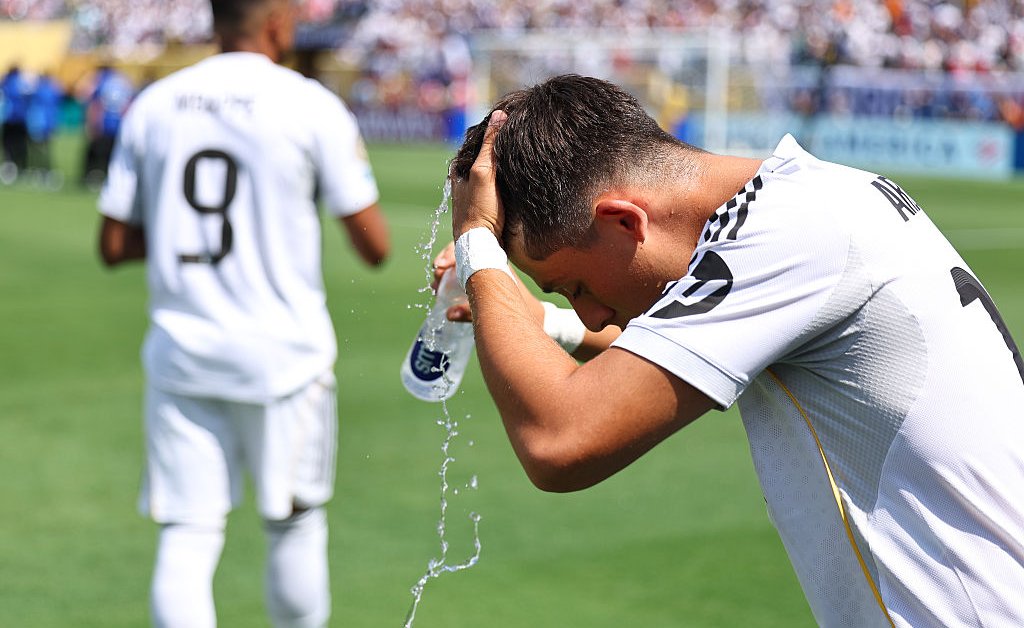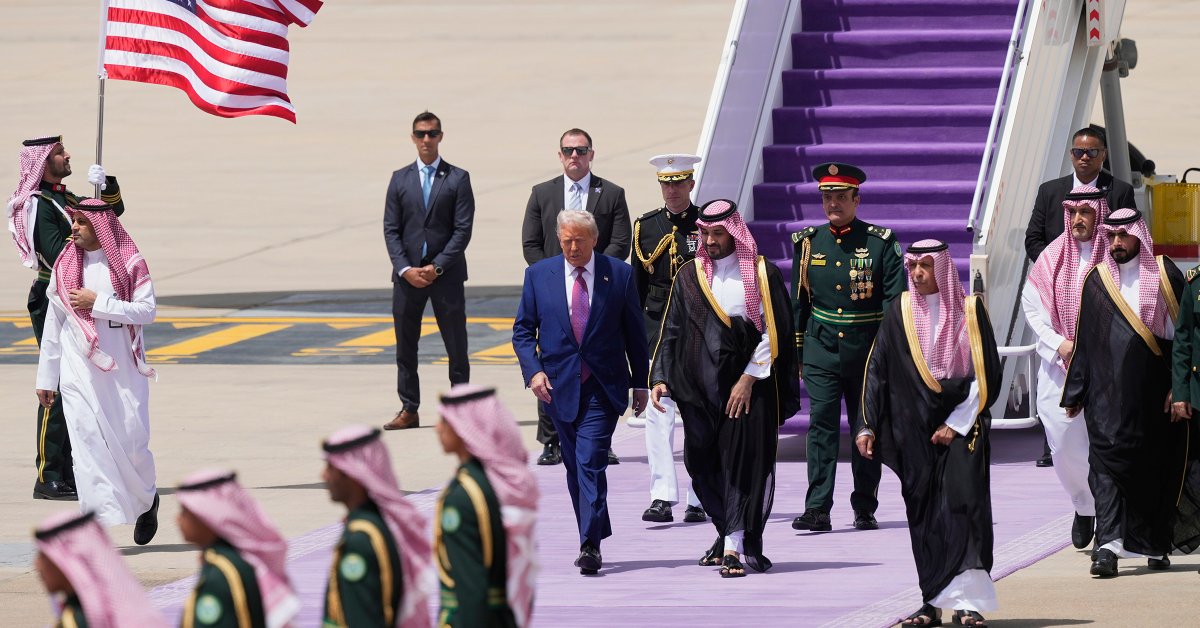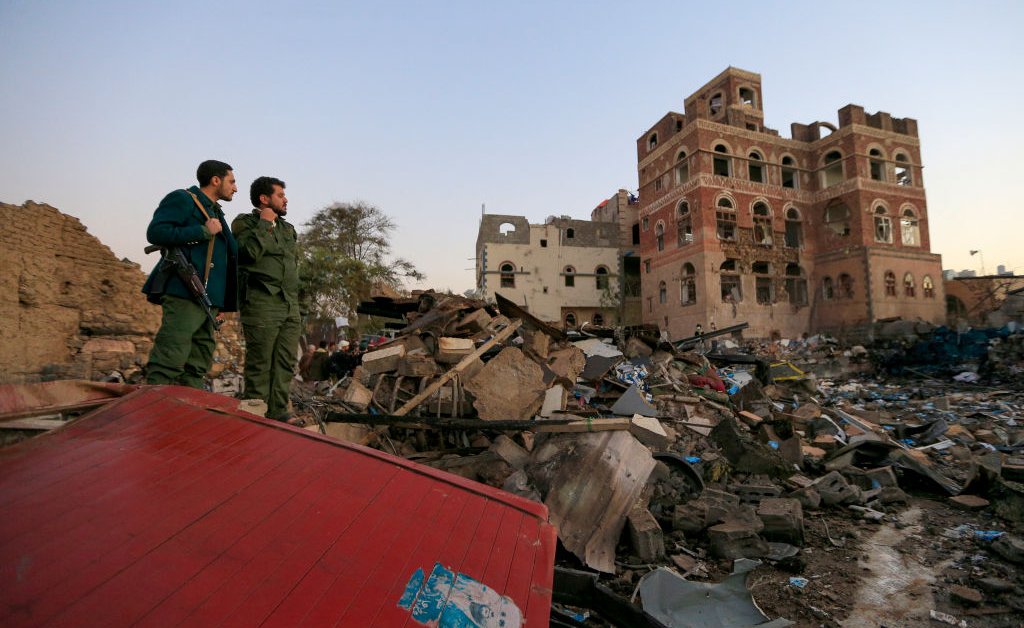Chelsea defied expectations on July 13 with a stunning 3-0 win against reigning European champions Paris Saint-Germain in the Club World Cup final. Players battled through scorching 85°F heat at MetLife Stadium in New Jersey, a persistent problem throughout the four-week tournament.
Extreme temperatures peaked when a record-breaking heat dome settled over the U.S. in late June. Amid a heat emergency in Philadelphia, Chelsea manager Enzo Maresca said it was “impossible” to train properly because of the 98.6°F weather. Midfielder Enzo Fernandez said the 96°F heat during Chelsea’s semi-final on July 8—a 3:00 p.m. kick-off at MetLife Stadium like the final—was “very dangerous.” It was so hot at one point that he “had to lie down on the ground” after feeling “really dizzy.”
The severe conditions have raised concerns ahead of the 2026 World Cup hosted in the U.S., Canada, and Mexico. The Club World Cup, held across 12 venues in the U.S., was a smaller dress rehearsal of next year’s tournament, but it also tested players’ capacity to withstand the realities of a warming world and how organizers and teams plan to protect them.
“Extreme temperatures can be particularly harmful as the body produces heat while exercising and needs to release that heat in order to cool down,” says Madeleine Orr, assistant professor of sport ecology at the University of Toronto. “But if the ambient temperature and humidity are too high and it’s impossible to sweat effectively, that can lead to trouble pretty quickly, starting with symptoms like fatigue, cramping, and nausea, progressing to more serious outcomes like exertional heat stroke if there’s no cooling intervention.”
Climate change is making extreme heat an increasingly significant issue across sports. In 2020, Australian rugby league player Keith Titmuss died aged 20 from exertional heat stroke after a pre-season training session. In 2021, Daniil Medvedev raised the prospect of dying to the umpire while playing tennis at the Tokyo Olympics, and 75% of athletes surveyed by World Athletics in 2023 said their health and performance had been negatively impacted by climate change.
The inaugural edition of the expanded Club World Cup has now increased fears that extreme heat will intensify the effects of soccer’s already overpacked schedule and how that will impact player welfare (an issue over which FIFPRO—the union representing over 66,000 professional soccer players globally—and domestic leagues are taking legal action against FIFA).

To help alleviate concerns about players being overworked, FIFA claimed to reach “consensus” over minimum rest periods with players’ representatives on July 12, agreeing 72 hours between matches and three weeks holiday between seasons. FIFPRO, however, wasn’t invited to the meeting where this decision was made. Those present included officials from organizations expelled from FIFPRO for corruption and former board members who were voted out of office. FIFA did not respond to TIME’s request for comment.
Ahead of the Club World Cup final, FIFPRO president Sergio Marchi said in a statement to TIME: “We have been warning about the overcrowded schedule, the lack of physical and mental rest for players, and the lack of dialogue on the part of FIFA. This way of organizing tournaments … [is] based solely on a logic of economic profitability, not human sustainability.”
FIFA guidelines usually permit one cooling break midway through each half when the Wet-Bulb Globe Temperature (WBGT) reaches 89.6°F. This standard is used around the world to determine when heat reaches a dangerous level, taking into account temperature, humidity, wind speed, sun angle, and cloud cover.
But scientists are concerned that the 89.6°F mandate underestimates player strain because WBGT only considers environmental factors. Following FIFPRO’s intervention early in the tournament, FIFA lowered the threshold for cooling breaks at the Club World Cup to 82.4°F, as well as increasing water, ice, and towels around the pitch. While Major League Soccer’s WBGT threshold is 84.2°F, FIFPRO states that matches should be postponed if the WBGT exceeds 82.4°F. Three Club World Cup matches exceeded these levels, including Benfica vs. Bayern Munich where temperatures peaked at 104°F in Charlotte, N.C. on June 24. “I don’t think I have ever played in this much heat before,” said 21-year-old Andreas Schjelderup after scoring for Benfica in a 1-0 victory. “I don’t think it’s healthy.”
In a June 30 FIFPRO media briefing attended by TIME, the union’s medical director Vincent Gouttebarge explained that FIFPRO’s WBGT threshold aims to prevent players’ core temperature—usually between 96.8°F and 100.4°F—from exceeding 104°F. At this point, there’s a risk of heat stroke where “you don’t sweat anymore because dehydration occurs,” he said, “you have a lack of muscle control, you can barely walk, in some cases your cognitive process is affected, and, in the worst case, you can lose consciousness.”
“FIFA seems quite happy with 89.6°F as a threshold because there have not been any serious heat-related illnesses in the sport up to this temperature,” says Christopher Tyler, reader in environmental physiology at the University of Roehampton, London. “But this is not the best evidence because players can down-regulate their intensity to lower heat strain,” for example, by sprinting less.
“The speed of the game is not the same, everything becomes very slow,” said Enzo Fernandez ahead of the final. “Let’s hope that next year they change the schedule,” he continued, protecting players and providing fans with a “beautiful and attractive football spectacle.” Following his side’s quarterfinal defeat against Real Madrid in 90°F afternoon heat, Borussia Dortmund manager Niko Kovac echoed this sentiment by suggesting evening kick-offs would raise the intensity of matches “much higher.” On June 21, Dortmund subs watched the first half of their match against Mamelodi Sundowns from inside the locker room to avoid the blazing midday 90°F heat in Cincinnati, Ohio, conditions Kovac likened to a sauna.

Almost 50% of Club World Cup matches were scheduled at either noon or 3:00 p.m. FIFPRO WBGT estimates shared with TIME, however, determined that if World Cup matches are played during the afternoon in Atlanta, Dallas, Houston, Kansas City, Miami, and Monterrey, there would be an “extremely high risk” of heat-stress injury.
To estimate the WBGT in 2026 World Cup host locations during an average summer, Queen’s University Belfast published a study in January 2025 that used meteorological data from 2003-2022. The researchers found that in June and July—the same period that the World Cup will take place—average temperatures in 14 out of 16 host cities experienced afternoon temperatures that frequently exceeded 82.4°F, while six cities typically exceeded the 89.6°F threshold.
Beyond changing the schedule, other solutions like cooling vests and cold-water immersion are becoming more common. Amid the Philadelphia heat wave, Chelsea used large fans to spray water on the players to cool down, while teams like Real Madrid prepared for the tournament using heated tents to help players acclimatize to conditions they’d have to play in.
Another option is deploying stadium roofs to shield against heat. Five 2026 World Cup stadiums in Atlanta, Dallas, Houston, Los Angeles, and Vancouver have roofs, which FIFA president Gianni Infantino said will “definitely” be used more for daytime matches. However, only 37.5% of matches are due to take place across these five venues.
FIFA could also schedule matches “proactively based upon forecast conditions,” says Tyler, but this isn’t without its challenges. Last-minute scheduling that’s dependent on the weather would create broadcasting and sponsor conflicts by scheduling more matches at times that aren’t ideal for the global television audience, particularly in Europe and Asia. This “scheduling Tetris,” as Orr describes, is even more complex after FIFA expanded the World Cup from 32 to 48 teams, meaning 104 matches instead of 64 and many times more fans.
The Club World Cup isn’t the first time that extreme weather has prompted schedule-change requests. At the 1986 World Cup in Mexico, 65% of matches were scheduled to kick off at 12:00 p.m. despite temperatures exceeding 100°F. Before leading Argentina to glory, Diego Maradona said at the time: “It should be part of the rules once and for all that the organizers should take the soccer players into account. Without us, there would be no spectacular. We are the indispensable ingredient to the World Cup. At least the hours of the games should be set to the time in which we play best, not when there is the most heat.”
Four decades later, the reality of climate change has kicked in and FIFA’s critics are hoping the governing body adapts faster to the rising threat of extreme heat. FIFPRO’s Marchi said in the statement shared with TIME that the “extremely hot” periods Club World Cup matches were played in are “unacceptable conditions” that “cannot be allowed to happen again under any circumstances” at the World Cup, demanding that FIFA puts players “at the heart of every decision.”
In FIFPRO’s June 30 media briefing, the union’s general secretary Alex Phillips said FIFA is “likely to be more flexible” over World Cup kick-off times after seeing the effects of extreme heat on the Club World Cup, but added that “we have absolutely no power to force them to.”








